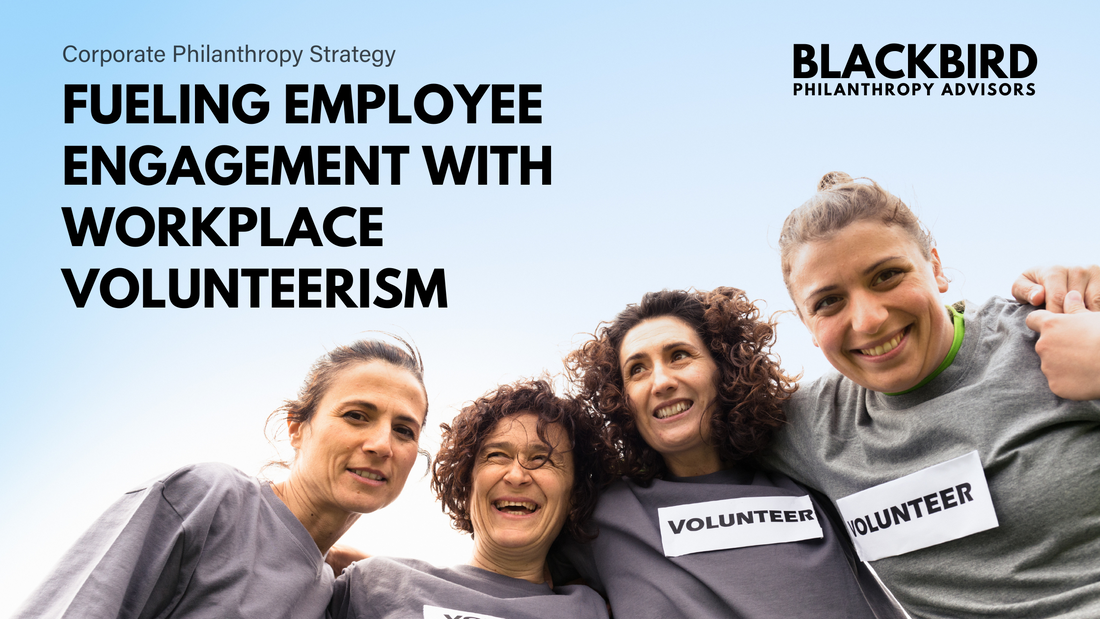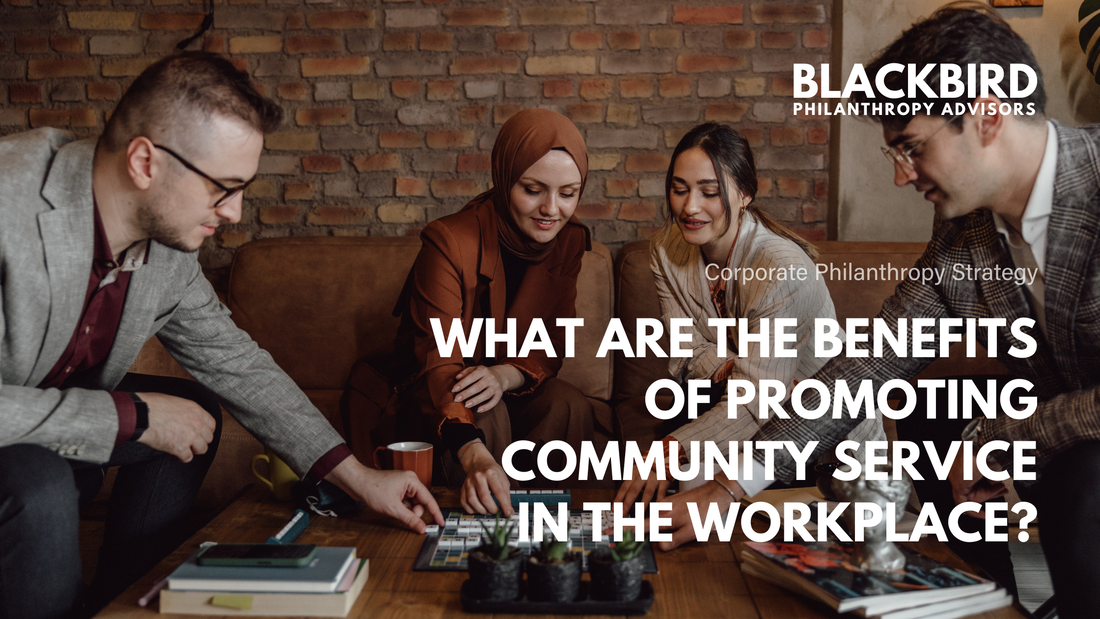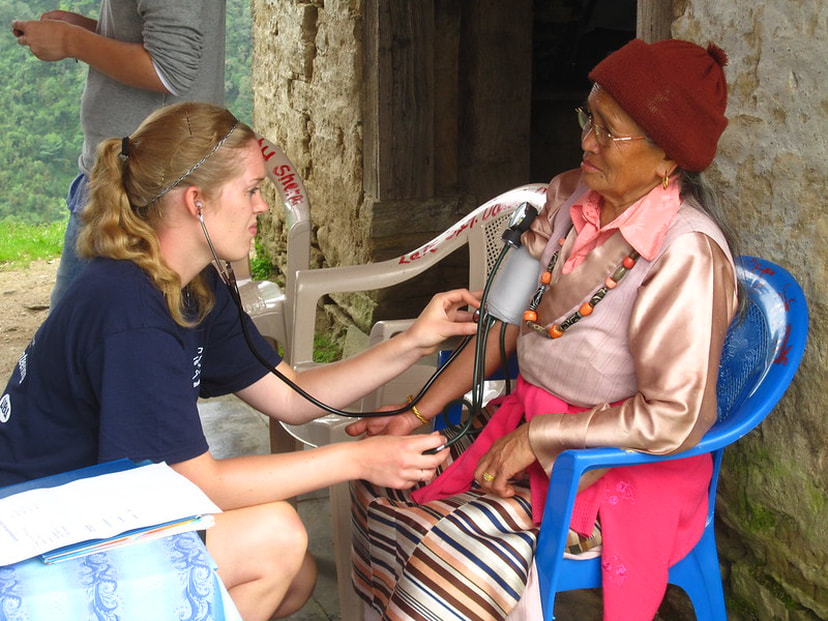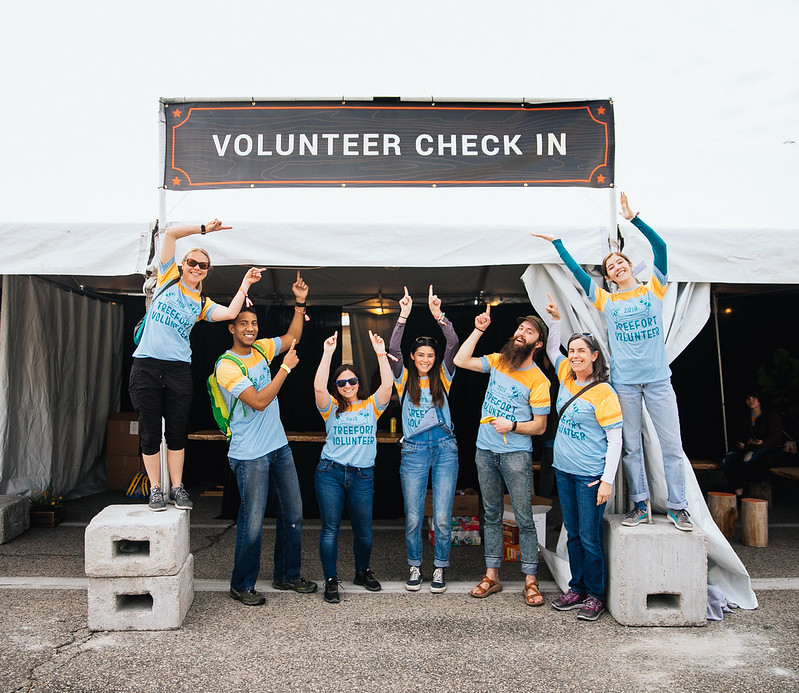Social Impact InsightsOur blog provides insights for social impact professionals in business and nonprofits. We offer advice on making the greatest impact in your organization by giving clear real-world advice on important topics of today.
|
|
When it comes to enhancing workplace dynamics and employee satisfaction, one area where data consistently supports positive outcomes is employee engagement. Engaged employees are more productive, less likely to turnover, and contribute significantly to a positive workplace culture. An effective strategy that is backed by robust metrics and research to boost employee engagement is workplace volunteerism. In this blog post, we'll delve into how encouraging employees to give back to the community can have a profound impact on your workforce and provide data-driven insights into its significance. Employee engagement is more importan than ever when it comes to attracting and retaining talent.
Encouraging volunteerism in the workplace is a proven tool to improve employee engagement.
Take steps to implement workplace volunteerism in your company.
Data-driven workplace volunteerism is not just a feel-good initiative; it's a potent tool for boosting employee engagement. By aligning your efforts with concrete metrics and research supporting the importance of both engagement and volunteerism, you can create a more engaged, motivated, and socially responsible workforce. Commence your journey toward a data-backed, purpose-driven workplace today, and witness the remarkable positive impact it brings, both within your organization and in the broader community.
0 Comments
In today's rapidly changing business environment, success encompasses more than financial gains and market leadership. An increasing number of companies are recognizing the transformative influence of giving back to the communities they serve. Engaging in volunteerism and community service not only nurtures positive societal change but also offers a multitude of advantages for businesses themselves. From elevated employee morale to a bolstered brand reputation, corporate social responsibility has become a fundamental aspect of modern business practices. Let's delve into the reasons and methods behind promoting volunteerism and community service, creating a substantial impact within the corporate workplace. The Significance of Volunteerism: Why It Matters
Strategies to Promote Volunteerism in the Corporate Workplace
Promoting volunteerism and community service within the corporate workplace is an endeavor that yields positive outcomes for all parties involved. It enhances employee engagement, fortifies company culture, and uplifts communities, all while enhancing the brand's reputation. By embracing the ethos of giving back, companies contribute to positive change and embody the values of compassion, empathy, and responsibility. As we navigate the ever-evolving business landscape, let's remember that success is not solely measured in profits, but in the constructive impact we leave on the world around us. If you're an employer competing for top talent in your industry, you may want to consider creating a formal plan to encourage volunteer service among employees. Working somewhere that encourages volunteer service can be important for several reasons.
As more and more companies recognize the importance of social responsibility and community involvement, many are turning to volunteer service programs as a way to give back and make a positive impact. However, simply encouraging employees to volunteer on their own time may not be enough to create a meaningful impact. To truly make a difference, companies need to develop a formal plan to encourage and support employee volunteer service. Here are some reasons why your company needs a formal volunteer service plan:
A formal volunteer service plan can provide numerous benefits to both employees and companies. By supporting and encouraging employee volunteer service, companies can improve employee engagement, build a positive reputation, support local communities, improve employee skillsets, and enhance corporate social responsibility. If your company has not yet developed a formal volunteer service plan, now is the time to do so and make a meaningful impact. If you're asked to serve as a member of the Board of Directors for a nonprofit organization, make sure you will be covered by Board Member D&O Insurance (Directors and Officer's Insurance). Most companies and nonprofits will cover the cost of this insurance for all board members, but if they refuse you have the option of purchasing a policy yourself. You also may want to think twice about joining a board that will not cover your exposure to financial risk.
What is Nonprofit Board Member Insurance? Nonprofit board member insurance (D&O insurance) is an important protection for those who volunteer their time and expertise to serve on the board of a nonprofit organization. Think of it as a safety net that protects you as a board member. It covers board members from the risks they may face while serving on the board, such as personal liability for decisions made in the course of their duties, legal fees, and damages they may be held responsible for. D&O Insurance is a type of liability insurance that covers the legal defense costs and any settlements or judgments that may result from legal action taken against you for alleged wrongful acts or decisions made in your capacity as a board member. Why Do Nonprofit Board Members Need D&O Insurance? If you are a nonprofit executive leader, you should spend the money to offer a policy to your Board of Directors. Having this insurance can demonstrates a commitment to responsible governance and can attract high-quality board members who value the protection that insurance offers. Nonprofit board member insurance is especially important in today’s world, where nonprofit organizations often take on complex and challenging projects, and face a variety of legal and financial risks. Board members are ultimately responsible for the decisions made by the nonprofit organization, and can be held personally liable for any mistakes or oversights. Even if the board member is not directly at fault, they may still be held liable for any losses or damages suffered by the organization. It's not a matter of if a lawsuit will happen, but rather when. As a nonprofit board member, you can be held personally responsible for any decisions or actions that result in financial loss or harm to the organization or its stakeholders. Even if the allegations against you are false or baseless, the legal defense process can be lengthy and expensive. D&O Insurance can give you peace of mind so you can and focus on your role as a board member without worrying about personal financial repercussions. Nonprofit board member insurance provides financial protection for board members in the event of any legal action taken against them. It can cover legal fees associated with defending the board member against any allegations, as well as any damages that may be awarded. In some cases, this insurance may even cover the cost of settling out of court. When is D&O Insurance Used? D&O Insurance can be used in a variety of scenarios. Here are some examples:
D&O Insurance is an essential component of any nonprofit organization's risk management strategy. As a board member, having this insurance in place can provide peace of mind and protect you from personal financial loss in the event of a lawsuit. It's important to ensure that the nonprofit you are involved with has this coverage in place to protect both the organization and its board members. Having the right insurance in place can help protect board members from any financial losses they may face due to their involvement in a nonprofit organization. It can also help to reduce the risk of financial ruin for the organization itself, as well as for its board members. If you need help finding a reputable, trustworthy risk management advisor for your nonprofit organization, contact us and we can help point you in the right direction. Taking popularity contests into consideration is not something that first comes to mind when engaging in charitable work. While we would hope that all organizations doing nonprofit work on behalf of a variety of causes are receiving the aid they need, this is simply not the case. There are differences when it comes to the type of causes that people like to fund. This doesn’t mean that it is impossible for less “popular” causes to raise money, but that more innovation and dedication may be required to raise funding for their goals. Those willing to rise to the challenges of these obstacles can still do great work for their causes.
Funding Priorities Around the World Donors around the world have different viewpoints on organizations they are willing to fund. A study from WealthInsight has shown that, overall, philanthropists are most involved when it comes to funding cultural institutions, academic institutions, and healthcare. In 2017 alone, health related charities saw a 15.5 percent rise in donations from American households. Causes that seemed to be less popular among donors in the world include religion, sports, human rights, and military causes. However, preferences vary by region with those in the Americas and Europe seeing more donations to health and culture causes while education dominates donations in Asia, Africa, and the Middle East. There are also more variations when you investigate each sector. While health may be a top priority for many philanthropists, areas in health that touch on issues like mental health, addiction, or sexual health see significantly less donations than health organizations that address topics like cancer. For example, the nine cancer charities in the top 100 fundraising charities have a combined income larger than the 13 charities in the top 100 related to other health issues. Facing the Road Ahead There’s plenty of actions organizations can take if they are looking to boost their donations. The key is showing others the importance of advocating and supporting the cause the organization is passionate about. Take an active role in educating about the cause and show evidence of the impact a donor’s funding can make. Continue to appeal to the public’s emotions and take advantage of opportunities to elevate the nonprofit’s profile. A good reference is an article published in the International Journal of Nonprofit and Voluntary Sector Marketing touching on “unpopular causes and how they can achieve fundraising success”. There may be a tough road ahead but, holding on to a positive outlook and having specific strategies on the fundraising journey can play an important role in how successful an organization is. Whether you have been giving for a few decades or just stepping into the philanthropic world, you might be curious about different styles of giving and wonder what your tendencies lean towards. Well, according to the Foundation Source, there are five common methods of giving that they have noticed among clients in the charitable giving world. Curious to see where you may fall within these categories? Read ahead to discover the five types of philanthropists!
Checkbook Philanthropists Those who are labeled checkbook philanthropists can be pictured as someone who whips out their checkbook without much notice or forethought and is ready to donate to needs as they come their way. There is more spontaneity when it comes to these donations and oftentimes, this means that they are simply happy to contribute to the organization’s work and do not expect much in return. Responsive Funders Philanthropists who are focused on a very specific cause or field of interest and actively respond to requests for funding within their interests. These types of donors can be good for nonprofit organizations targeting strategic philanthropy because they know the exact guidelines and circumstances under which responsive funders are willing to provide monetary support. This concentrated focus on certain giving areas can be very impactful to organizations in those sectors. Venture Philanthropists Donors who focus on applying venture capital tactics and strategies using hands-on involvement and mentorship fall under venture philanthropists. They are much more likely to be involved with the organization in more ways from day-to-day tasks and with setting goals for long-term success. Venture philanthropy is looking to grow organizations. Results-based Philanthropists Those who want to fix the problem and not just treat the symptoms are results-based philanthropists. These donors work with individuals involved on all levels from nonprofits to government sectors to make an impact. They are more likely to invest a lot of time in researching nonprofit organizations before taking any on as a philanthropic project. This is because they have a desire to understand all aspects of the problem before setting and tackling achievable goals. Collaborative Funders Those who understand the need for the involvement of multiple parties to work towards a common goal are collaborative funders. This could involve bringing together family foundations, corporate philanthropists, etc. to share the responsibilities of supporting a cause based on their ability. These types of philanthropic setups involve diverse individuals concentrating on specific tasks to accomplish an overall goal. About a decade ago, a number of the world’s influential billionaires came together to share ideas on how they could motivate other wealthy people to contribute their wealth to philanthropy. This was the inception of “The Giving Pledge,” a campaign that encouraged the rich to dedicate at least half of their wealth to philanthropic efforts.
Background "The Giving Pledge” was a campaign that was discussed at a private dinner meeting in May of 2009 that consisted of some of the most well-known billionaires like David Rockefeller, Michael Bloomberg, and, reportedly, even Oprah Winfrey. While this meeting was kept secret when it occurred, a year later, its hosts, Bill Gates and Warren Buffet announced the launch of the modest campaign. This desire for change was fueled by the lack of donations from the billionaire population. The call for action was not too specific or demanding. It requested that billionaires pledge 50 percent of their fortune to philanthropy. Those who made the pledge would not be bound by requirements meaning they could give to any causes they desired through any method and without time constraints, although donations to political parties would not count. Gates and Buffet hoped that the relaxed guidelines would serve as a strategic choice to get more billionaires to commit to donating. At its start, 40 of America’s wealthiest individuals signed up for the commitment and it has since grown to over 200 of the world’s richest individuals, couples, and families from 25 different countries. The pledge works by having those who sign up issue a public commitment towards its mission. Those involved are able to independently work on their contributions and are then invited to an annual gathering to celebrate, share, and learn from one another as well as experts. These billionaires come from different backgrounds and have diverse philanthropic interests ranging from issues including poverty, education, health, research, environmental sustainability, etc. A full list of pledge signatories can be found on the pledge’s website. It also includes the public pledge that each signatory released at the time of commitment. Here are just a few of the pledges made:
While the purpose of the pledge was to encourage billionaire’s to contribute their wealth, the sentiment of giving generously is relevant to capable donors of any financial status. For some insight on strategic giving, visit our blog for information! One of the considerations that comes up when you decide to participate in charitable giving is the topic of anonymity. Depending on the type of person you are and the effects you are looking for, giving anonymously may seem like the way to go rather than making your donations well-known to everyone. There’s arguments for each side and ultimately, the decision is up to you. Before making your next philanthropic move, weigh the advantages and disadvantages of giving anonymously and publicly.
Giving Anonymously There are plenty of factors that go into making the decision to be anonymous in your giving. These can include your background, the organization you are supporting, etc. Here are the advantages and disadvantages associated with giving anonymously: Disadvantages
Advantages
Giving Publicly Disadvantages
Public donations are preferred by many organizations and offer them more opportunities and benefits than you may realize. For example, the more donors they are able to publicly include on their list, the more likely they are able to grow their work with the community. Not only does your donation help fund their projects, you name attached to a charitable gift can be used to help elevate fundraising efforts, create compelling stories, and help the organization build a relationship with you as a donor. Joining the board of directors for a nonprofit organization can be a major responsibility as well a major source of pride and excitement. Guiding a nonprofit and being along to see it obtain its goals is a worthwhile experience. But there are a few things to consider before taking on this role. Nonprofit board members should be actively involved with the organization and are expected to contribute financially in some shape or form whether this be through giving your time, dedicating your skills towards advancing the organization, or donating money. Before making the decision to become involved with a board of directors, make sure you understand the commitment you’re making as well as the organization you are serving.
1. Can I see a copy of your latest IRS Form 990? A form 990 is the form submitted to the IRS to determine whether or not a nonprofit organization can maintain its tax-exempt status. This form will include all of the nonprofits income and expenses including any money they have awarded through scholarships or grants, salaries of the organization’s five highest paid employees, donations, fundraising, etc. As a potential board member, you can use this form to evaluate the financial health of the nonprofit and whether its spending and saving habits fall in line with your expectations as a future member on their board of directors. Most nonprofits will make this form available to those who request it and some may even be found online through sites like Guidestar. 2. How much will I be expected to give each year? When you join a board of directors for an organization, it is usually expected that members will make some sort of personal contribution to the organization themselves. Board giving is a common way to demonstrate your support to the organization you serve and also positions you as a role model in the community for other donors. Expectations can vary based on the nonprofit you are working with so be sure to get informed before getting involved. 3. How much will I be expected to raise each year? Fundraising should always be one of the top priorities for board members. This is one of the key ways many nonprofit organizations raise enough money to accomplish their goals. Board fundraising can look like a variety of situations from creating connections with your own circle and identifying prospective donors to helping with fundraising initiatives and requesting gifts. It also includes bringing in resources, support, and skills into the organization. Volunteers contribute greatly to nonprofit organizations. According to the 2018 Volunteering in America report, 77 million people volunteered in the United States. These volunteers make significant impacts on the organizations they are serving and doing volunteer work not only benefits others, it benefits the volunteers as well. Many companies have taken the initiative to encourage workers to volunteer in their time off or have dedicated days to put towards service events. But, what can your company do to encourage employees to continue serving their communities while ensuring their safety during the COVID-19 pandemic?
COVID Effects on Volunteering COVID-19 has restricted the work people have been able to participate in. To prevent the unintentional spread of the virus, gathering is discouraged and attending in-person volunteering is not as feasible as it was before. Many are choosing to stay home to protect themselves and their families from being exposed. This means that communities nonprofits serve will start seeing a lag in service or decreases in resources available. There are many reports that nonprofits are struggling to keep up with the workload due to the decrease in volunteer numbers. For example, Hunger Task Force, Inc. doesn’t have enough volunteers to help pack food boxes for seniors living in the Milwaukee area. COVID-19 has changed the way we go about our lives, but many have found ways to continue supporting their communities through volunteer work while staying safe. Socially Distanced Volunteering Opportunities Safe volunteering can take place at home. There are plenty of needs that still need to be addressed even in a pandemic.
Virtual Volunteering Opportunities Virtual volunteering events have also emerged in the past few months. These events can be just as beneficial as those that are taking place in person.
Group Volunteering Under Safe Conditions Nonprofits looking to host in-person events still have the option to do so by taking advantage of outdoor spaces. Some have invited the community to a local park with socially distanced work stations for each household to work on service projects like blanket making, card writing, or food or toy collections. The key guidelines to keep in mind are to maintain distance, sanitize often, ask those who show symptoms to stay home, and implement tools so contract tracing is easy in case there is an exposure. While the pandemic has shut down many activities, it’s important to continue encouraging acts of service. Especially in times of global crisis, these volunteer hours can end up being more impactful than before. Whether your company decides to look into remote volunteering projects or seek out safe and socially distanced opportunities, the work provided will make a difference in the lives of others. The Board of Directors of a nonprofit organization is tasked with the responsibility of considering, discussing, and voting on the affairs, actions, and decisions of the nonprofit. Being a member of the board can allow you to have some say in how money is spent, where resources are allocated, which steps the nonprofit will take next, and much more. If you are particularly interested in or dedicated to the work being done by the nonprofit, working on the board can allow you to make an impact on a cause you care about.
While some nonprofits are desperate for board members, and will happily take volunteers that are willing to dedicate their time and energy, others are more selective and require potential board members to prove themselves before being considered for a slot at the table. If you have found a nonprofit that you feel passionate about, and want to become more involved by joining their board of directors, here are a few pieces of advice to keep in mind:
Want more tips, tricks, and advice on living a philanthropic life? Visit Blackbird Philanthropy Advisors today, and be sure to visit our blog for more information. Creating a thriving and efficient work environment isn’t always about what happens in the office - sometimes, it’s the time you encourage your employees to take off that makes the biggest difference. Offering your employees volunteer time off is an amazing way to get them engaged in the community, can help boost the image of your company, and can help further the mission of your business. What is VTO? Like paid time off, volunteer time off (VTO) policies offer employees the chance to take a day off with pay. Rather than going on vacation or taking sick leave, VTO is for volunteering. Offering paid days off to your employees encourages them to take advantage of the opportunity, and can even help boost employee morale. Most companies that offer VTO offer somewhere between 8 and 80 hours per year, with some even offering employees the chance to take paid sabbaticals to dedicate themselves purely to volunteering. An organization offering VTO can choose just how much time they will allow, and can even dictate which organizations employees should volunteer with to qualify. By requiring employees to volunteer for specific causes and organizations, you’ll be able to direct time, energy, and effort toward a cause that matters to you and your business. Some companies require employees to take at least 8 hours of VTO throughout the year, implementing mandatory minimum volunteer hours for all members of staff. Other companies leave the choice entirely up to the employee, allowing them to request as much or as little VTO as they want. Approving employees for VTO is a relatively straightforward process, and requires little more than a simple scheduling protocol for employees to submit requests for VTO with reasonable advanced notice. What Are the Advantages of a VTO Policy? Some business owners might frown at the idea of paying their workforce to ‘work’ elsewhere for a day, but despite the lost working hours, there are plenty of advantages to implementing a VTO policy in your organization.
Companies that Offer VTO If you decide to begin offering your employees VTO, you’ll be joining the more than 65% of companies that already have these programs in place. Some of the biggest, most well-known corporations are also those with the most generous VTO policies, and more and more professionals are beginning to expect their employers to dedicate a portion of their resources to community and social programs. Here are just a few of the companies that offer VTO to their employees:
How You Can Create a VTO Policy If you haven’t already, now is the time to begin offering your employees paid volunteer time off. Creating a basic VTO policy is fairly simple, and if you already have a PTO policy in place, you will be able to follow its basic framework. Some important details for your VTO policy to include are:
Ready to take it to the next level? These are companies who are going above and beyond and offering an even greater depth to their community service programs:
Want to learn more about making a difference in your community? Visit Blackbird Philanthropy Advisors insights blog to discover much more. Some people give simply because they know they should, and offer up charitable donations out of some kind of moral obligation. While it is true that we should all do our best to give back, this sentiment of obligatory philanthropy is readily going out of style.
The next generation of philanthropists, the 20-somethings, are giving to those causes they feel personal connections to, rather than giving simply for the sake of giving. Young people like to engage personally with the causes they support, and are building philanthropy plans that reflect their interests and values. If you are a 20-something and have been wondering whether it is time you create a philanthropy plan, the answer is: it’s never too early to start giving! Building the habit of generosity and learning support causes that impact you and your community from an early age will help you to feel more connected to your community, and will help you to build patterns of empathy. Many younger people with charitable sensibilities shy away from engaging in philanthropy because they believe that they need to have tons of expendable income to make an impact. In truth, young philanthropists can contribute to nonprofit and community organizations in many ways, including but not limited to financially. How You Can Give Back Without Having Money While even the smallest financial donation is appreciated by nonprofit organizers, not all young philanthropists can afford to donate money. Instead, try donating something else, like your time. Volunteer, serve on boards or committees, offer professional pro-bono services, or find some other creative way of donating your time. Many nonprofits often need additional volunteers to help with basic administrative tasks, to help organize or clean their facilities, or to simply spread the word about their cause. Donating your time is just as rewarding - if not more - than donating your money, and the sooner you begin contributing to causes you care about, the sooner you will feel the benefits of generosity. Once you start giving back, we know you won’t want to stop, which is why we encourage you to keep changing your philanthropy plan as often as necessary. As you, your career, and your life grow, you will find new ways to contribute to the causes that mean the most to you. Creating a basic philanthropy plan in your 20s is just the first step. Learn more about philanthropy and how you can make a difference when you visit Blackbird Philanthropy Advisors. We offer more information like this on our blog, where you can discover tips, tricks, and advice for volunteering, corporate giving, fundraising, and much more. Philanthropy might be a big word, but that doesn’t mean it can’t be a super kid-friendly topic! Kids loving giving and being generous, and often have a great sense of compassion and duty to their friends and family. Because of this, engaging your kids in conversations and activities to help them start thinking about philanthropy can be a great way to spend more time together, and to foster good habits for their future. Here are just a few simple ways you can get your kids excited about philanthropy.
Show Your Kids Positive Results You can explain the concept of charitable giving to a child, and they will likely understand, but younger children may not fully be able to understand the real impact of philanthropy. A good way to help your kids understand the impact they can have is to choose a cause that offers visual results. Consider donating, for example, to charities offering treatment and surgery to children with cleft palate or cleft lips. Before and after photos of these kinds of operations can show your children exactly where their donations are going, making the action seem more important and real. Volunteer as a Family Younger children may not have the same understanding of the value of money as older children, which is why it can be extremely valuable to expose them to volunteer opportunities. Volunteering within your community is an excellent way to show them that there are things that can be done within your community and that they are an important part of said community. Volunteering can also help to solidify the real impact of philanthropy, showing your kids that there is value in work and satisfaction in helping others. Encourage Kids To Think with Empathy Shielding children from hardship and pain is an instinct, but that doesn’t mean you shouldn’t share facts of life with your kids. If, for example, a person experiencing homelessness approaches you and your child, be kind and generous with that person. After, be sure to engage your child in a conversation regarding what kinds of things might lead to a person being homeless. Your kids can empathize with other people, and early fostering of this skill can help to make them more understanding, empathetic, and kind as adults. Want to learn more about becoming involved in philanthropy? Visit Blackbird Philanthropy Advisors online today, and be sure to check out our blog for many more helpful tips, tricks, and bits of information! 
 Our brains are hardwired to serve. Here is why businesses and their employees benefit from embracing meaningful causes. By Susan SteinbrecherCEO, Steinbrecher and Associates@SteinbrecherInc Published by Inc. Magazine, May 31, 2019 At a recent celebration for Harvard Business School's Class Day, speaker Michael R. Bloomberg, extolled the value of graduates aligning themselves with companies that were deeply committed to philanthropic efforts, stating that at Bloomberg, "...philanthropy gives us a competitive advantage in recruiting and retaining talent -- and it's as good for the bottom line as anything a company can do." Literally translated, the word philanthropy means "love of humanity." By very definition, philanthropy is only philanthropy when it stems from giving without personal gain. It begins and ends with a selfless motive -- that of helping one's fellow man without seeking recognition or reward. Most of us know that charity is its own reward. The true wealth of charity is measured by good deeds, not ego and material gain. That's why many affirm that they get back far more than they give. In other words, what they receive is the joy of love in action, the manifestation of their gift of time or money in such a way as to make a visible difference. Interestingly, good people doing good work experience benefits that go beyond just their contentment in the knowledge that they are advancing the well-being of humanity. A well-known study examined the brain activity of a group of people, each of whom was given money ($128) and asked to make choices about whether to keep the money for themselves or to give some or all of it to charity anonymously. The outcome was fascinating. The participants who gave the money to charity experienced an extremely high level of pleasure. The researchers concluded that, "The warm glow that many donors get from giving to charity involves the same brain mechanisms that evoke pleasurable sensations after sex, eating good food, and using heroin or other drugs." Companies that embrace philanthropic efforts enjoy significant advantages that contribute to the mutual benefit of both management and employees on every level such as: Loyalty and morale rise. This occurs in direct correlation to the enhanced sense of personal engagement and connectedness of the employees since they are proud to be associated with a company that cares and does good for others. Employees experience an increased sense of personal satisfaction. The reward that goes with being part of a meaningful community effort is something bigger than themselves that makes a difference in the lives of others. Team building. This happens at a higher level since all employees are working side by side together towards a common goal. A sense of accomplishment. The collective group can work together to achieve something for the community while serving as a profound team-building event for the employees. We've been taught since we were children that it is better to give than to receive. This Chinese proverb illustrates the intrinsic worth of charitable works: "If you want happiness for an hour, take a nap. If you want happiness for a day, go fishing. If you want happiness for a year, inherit a fortune. If you want happiness for a lifetime, help somebody." Many people wonder if their volunteer time at a charity completing professional tasks can be deducted on their taxes. You cannot deduct the value of services rendered in volunteer service to a nonprofit. You can, however, deduct the expenses you incurred while volunteering or traveling to and from the volunteer assignment.
Example 1 - The Artist: An artist who paints a mural on the wall of her local local Boys & Girls Club can deduct the cost of paint, paint brushes, and other supplies needed to complete the mural. She can also deduct the gas mileage it took to get to and from the charity to complete the volunteer service. She cannot deduct for the time it spent her. Example 2 - The Nurse: A Red Cross volunteer who is a Registered Nurse travels to Florida to help with hurricane disaster relief recovery. He can save the receipts for his airfare, lodging, and meals while on assignment. He cannot calculate the hours he spent working as a nurse for Red Cross and deduct the pay he would have been paid in his workplace. Always consult with your tax advisor to be certain. Volunteering is a great way for teens to explore higher education and career options while forming their identities as individuals. Through volunteer work, teens can build confidence, independence, leadership, and social skills that will catapult their lives into adulthood. In addition to building soft skills, teens can gain valuable hard skills related to computer systems, basic financial transactions, care taking, etc. that will show future employers and college admissions teams that they are responsible, reliable, and self-directed.
In general, volunteer jobs involve more scheduling flexibility than paid youth jobs and could be ideal for youth who are interested in holding a job but who cannot due to sports, extracurricular, and other academic commitments. How to Find the Right Cause Teens are often so curious about many different things in life. Volunteering on day projects for organizations is a great way to narrow down your interests to make a fuller weekly commitment to a cause you care about. Many communities have a local United Way who can serve as a liaison to match a teen volunteer with a cause of which they find to be interesting. There is no shortage of fantastic nonprofit organizations who rely on volunteer labor to fulfill their mission. Different Ways to Help Nonprofit organizations are always looking for bright, dependable, hard working young people who are committed to making a difference in the world. Once you narrow down the cause you are most passion about, write an email to the nonprofit’s volunteer coordinator or administration and make your case. You may start off working on menial or repetitive volunteer tasks but if you prove yourself to be committed and reliable, a volunteer position could turn into something even more valuable and rewarding. If you’re a budding writer, instead of stuffing hundreds of envelopes with a newsletter insert, they may eventually rely on you to write a feature or two in the newsletter. If you’re a basketball star and want to be a coach one day, you may go from cleaning the gym after youth practices to coaching one of the teams. |
 RSS Feed
RSS Feed























